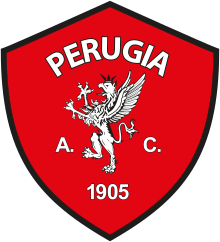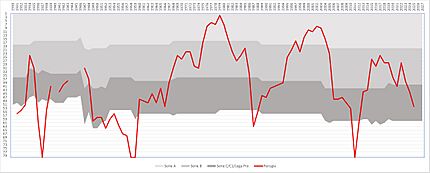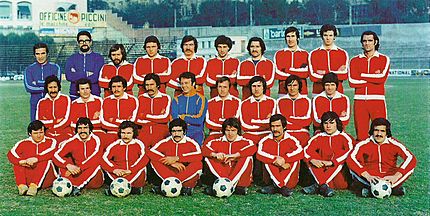AC Perugia Calcio facts for kids
 |
||||
| Full name | Associazione Calcistica Perugia Calcio S.r.l. | |||
|---|---|---|---|---|
| Nickname(s) | I Grifoni (The Griffins) | |||
| Founded | 1905 1935 (re-founded) 1940 (re-founded) 2005 (Perugia Calcio) 2010 (AC Perugia) |
|||
| Ground | Stadio Renato Curi, Perugia, Italy |
|||
| Capacity | 23,625 | |||
| Chairman | Javier Faroni | |||
| Head coach | Vincenzo Cangelosi | |||
| League | Serie B | |||
| 2018–19 | Serie B, 8th of 19 | |||
|
||||
Associazione Calcistica Perugia Calcio, often just called Perugia, is a professional football club from Perugia, Umbria, Italy. The team currently plays in the Serie B, which is the third division of Italian football.
The club was first started in 1905 as Associazione Calcistica Perugia. It faced financial problems and was re-founded a few times. It became Perugia Calcio in 2005 and then took its current name, AC Perugia, in 2010.
Perugia has played 13 seasons in Serie A, Italy's top league. Their best result was finishing second in the 1978–79 season without losing a single game. This made them the first team in Serie A history to go unbeaten in a full season, even though they didn't win the championship.
The club has also won the 2003 UEFA Intertoto Cup and played in the UEFA Cup twice. During the early 2000s, under club president Luciano Gaucci, Perugia had some famous home wins. One of the most memorable was against Juventus in 2000. This win caused Juventus to lose the league title to Lazio.
Perugia's players are known as "biancorossi" (red and whites) because of their red shirts and socks with white shorts. They are also called "grifoni" (griffins), which comes from the griffin symbol of their city. Their home games are played at the Stadio Renato Curi, which can hold 23,625 fans. In the 1979–80 season, Perugia was the first Italian football team to have a sponsor's logo on their kit.
Contents
Club History
Early Years of A.C. Perugia (1905-1950s)
A.C. Perugia was formed on June 9, 1905. This happened when two local sports clubs, U.S. Fortebraccio and Libertas, joined together. In its early days, the club mostly played in regional competitions.
During the 1930s, Perugia grew stronger. They were promoted to Serie B for the first time in 1933. In 1937, Perugia built its first official stadium, called Santa Giuliana. After another promotion to Serie B in 1945–46, Perugia spent most of the 1950s playing in lower divisions.
A.C. Perugia's Rise (1960s-1975)
The 1960s saw Perugia start to become successful again. This was under the leadership of local businessman Lino Spagnoli. The team was promoted to Serie B in the 1966-1967 season. This marked the start of one of the club's best periods.
Perugia played in Serie B for the next eight years. Then, in 1975, they were promoted to Serie A for the very first time. The club brought in new leaders, including Franco D'Attoma as president. They also hired Ilario Castagner as coach and Silvano Ramaccioni as sporting director. New players like Pierluigi Frosio, Franco Vannini, Renato Curi, and Paolo Sollier joined the team. Perugia earned their promotion to Serie A with a clear lead over other teams.
The D'Attoma Era and Unbeaten Season
Perugia, now in Serie A, played their first top-league match against Milan on October 5, 1975. They played in their new home, the Comunale di Pian di Massiano stadium.
On May 16, 1976, Renato Curi, a key player for Perugia, scored an important goal against Juventus. This goal helped Torino win the championship that year. Perugia also played in a European competition for the first time, the Mitropa Cup.
Curi's great play helped Perugia finish sixth the next season. Sadly, on October 30, 1977, Renato Curi passed away from a heart attack during a home game against Juventus. The stadium was later renamed in his honor to Stadio Renato Curi.
Even after this sad event, Perugia continued to do well. The next season, 1978–79, they made history. They became the first team to finish a Serie A season without losing a single game. They had 11 wins and 19 draws, finishing second in the league behind AC Milan. This amazing team was known as the "Perugia of miracles." Their unbeaten run in Serie A lasted for 37 matches. Key players included captain Pierluigi Frosio, Franco Vannini, Antonio Ceccarini, and Salvatore Bagni.
Before the 1979–80 season, Perugia signed Paolo Rossi, a famous Italian national team striker. President D'Attoma also made a groundbreaking deal with a pasta company. This was the first time an Italian football team had a sponsor's logo on their kit.
Despite Rossi's goals, the team struggled to repeat their earlier success. They finished seventh in the league. Their first UEFA Cup appearance ended early. In March 1980, a major football betting scandal, known as the Totonero scandal, affected many clubs and players, including Perugia. The team was penalized five points for the next season, which led to their relegation in 1981.
Perugia in the 1980s
In the first half of the 1980s, the club tried to get back to Serie A. They came very close in the 1984-1985 season under coach Aldo Agroppi. They missed promotion by just one point and set records for the fewest defeats and most draws in Serie B.
However, the club's difficulties continued. In 1986, they faced further penalties due to another football scandal, which caused them to drop down to Serie C2. During this time, a talented young player named Fabrizio Ravanelli was discovered. He later became a famous player for clubs like Juventus and Middlesbrough before returning to Perugia.
The Gaucci Years (1991-2005)
In 1991, businessman Luciano Gaucci took over the club. He was president until 2005 and had a big impact. His time included trying to sign the first female footballer for a men's Serie A team. He also saw the team's unexpected win against Juventus in 2000 and their victory in the 2003 UEFA Intertoto Cup in 2003.
Gaucci was known for his unique way of dealing with players and coaches. He wanted to get Perugia back to the top league quickly, and he did so within five years. He brought in important players like Giuseppe Dossena and Giovanni Cornacchini. After a small setback, Perugia was promoted to Serie B in 1993. The 1993–94 season saw Perugia, led by Ilario Castagner again, win their group and get promoted to Serie B.
Perugia stayed in Serie B for only two seasons. They achieved promotion to Serie A in the 1995–1996 season under coach Giovanni Galeone. With captain Federico Giunti and striker Marco Negri, Perugia secured their return to the top league after fifteen years.
Perugia started well in Serie A, but then Gaucci changed coaches. The team's performance dropped, and they were relegated. However, with Castagner back as coach, Perugia won a play-off and returned to Serie A.
For the next six seasons, Perugia stayed in Serie A. They brought in international players like Japanese star Hidetoshi Nakata and Ecuadorian top scorer Ivan Kaviedes. The club faced controversy when Gaucci ended the contract of South Korean player Ahn Jung-Hwan. This happened after Ahn scored the winning "golden goal" that knocked Italy out of the 2002 FIFA World Cup.
In 2003, Perugia signed English striker Jay Bothroyd and Al-Saadi Gaddafi. The club also won the 2003 UEFA Intertoto Cup by beating VfL Wolfsburg 3–0. This win allowed them to play in the 2003–04 UEFA Cup, where they reached the third round. Gaucci's time as president ended when the club faced financial difficulties and was relegated in 2004.
Perugia Calcio (2005–2010)
In 2005, a new chairman, Vincenzo Silvestrini, re-established the club as Perugia Calcio.
In 2009, Leonardo Covarelli took over the club. However, on May 21, 2010, the club was declared bankrupt. No one bought the club at auction, and on June 30, 2010, it could not join the Italian third-level championship. The Italian Football Federation officially ended the club's membership on July 8, 2010.
A.C. Perugia Calcio (2010–Present)
In July 2010, a new club was formed with a similar name, ASD Perugia Calcio. It continued the history of the old team and joined Serie D. Roberto Damaschi became the chairman.
On April 10, 2011, Perugia was the first team that season to be promoted from Serie D. They moved up to the Lega Pro Seconda Divisione. The club also won the Coppa Italia Serie D in 2010–11.
In summer 2011, the club changed its name to Associazione Calcistica Perugia Calcio. They played in the Lega Pro Seconda Divisione/B and were immediately promoted to Lega Pro Prima Divisione. On May 4, 2014, AC Perugia won the 2013–14 Lega Pro Prima Divisione championship. This earned them promotion to Serie B after nine years away. Massimiliano Santopadre also became the full owner of the club.
On May 2, 2021, Perugia finished first in their group in the 2020–21 Serie C. This meant they were promoted back to Serie B. They achieved this after winning their last five games of the season. The club was relegated back to Serie C at the end of the 2022–23 Serie B season.
Team Players
Current Squad
|
|
Players on Loan
|
Coaching Staff
Club Achievements
League Titles
- Serie A
- Runners-up: 1978–79 (finished second)
- Serie B
- Winner: 1974–75
- Serie C1
- Winner: 1932–33, 1966–67, 1993–94, 2013–14, 2020–21
- Serie C2
- Winner: 1987–88, 2011–12
Cup Wins
- Supercoppa di Lega Pro
- Winner: 2014
- Supercoppa di Serie C2
- Winner: 2012
- Coppa Italia Serie D
- Winner: 2010–11
European Competitions
- UEFA Intertoto Cup
- Winner: 2003
League History
| Series | Years | Last Season Played | Promotions | Relegations |
|---|---|---|---|---|
| A | 13 | 2003–04 | - | |
| B | 29 | 2022–23 | ||
| C +C2 |
33 +3 |
2023–24 | ||
| 78 out of 92 years of professional football in Italy since 1929 | ||||
| D | 13 | 2010–11 | never | |
| E | 1 | 1929–30 | never | |
Club Records
- Serie A:
- Runners-up and unbeaten: 1978–79
European Matches
UEFA Cup
| Season | Round | Club | Home | Away | Aggregate | Reference |
|---|---|---|---|---|---|---|
| 1979–80 | First Round | 1–0 | 0–0 | 1–0 | ||
| Second Round | 0–3 | 1–1 | 1–4 | |||
| 2003–04 | First Round | 1–0 | 2–1 | 3–1 | ||
| Second Round | 2–0 | 1–1 | 3–1 | |||
| Third Round | 0–0 | 1–3 | 1–3 |
UEFA Intertoto Cup
| Season | Round | Club | Home | Away | Aggregate | Reference |
|---|---|---|---|---|---|---|
| 1999 | Second Round | 1–0 | 0–0 | 1–0 | ||
| Third Round | 0–3 (f) | 2–1 | 2–4 | |||
| 2000 | Second Round | 1–2 | 1–1 | 2–3 | ||
| 2002 | Third Round | 2–1 | 1–3 | 3–4 | ||
| 2003 | Third Round | 2–0 | 2–0 | 4–0 | ||
| Semi-final | 0–0 | 1–0 | 1–0 | |||
| Final | 1–0 | 2–0 | 3–0 |
See also
 In Spanish: Associazione Calcistica Perugia Calcio para niños
In Spanish: Associazione Calcistica Perugia Calcio para niños




